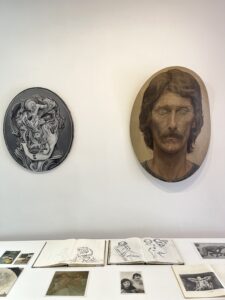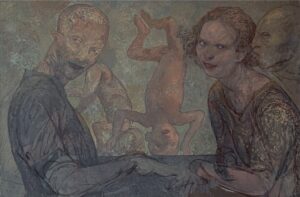This article was updated on April 2, 2024.
Artist Richard Iammarino was “starting a new series of pictures, returning to figurative work after years of abstraction” when he died suddenly at home in his studio on Jan. 28, 2024, according to his son Steven. He had just finished a group of drawings for a show at Spiritus Pizza in Provincetown, Steven said. The cause of death was chronic obstructive pulmonary disease. Richard was 86.

The son of Anthony and Lenore (Mulholland) Iammarino, Richard was born on Feb. 13, 1937, in Cleveland, Ohio. His father worked for General Motors and designed wallpaper on the side; his mother stayed home to raise her four children.
When he was seven, urged by his aunt, he took the tram to the Cleveland Museum of Art and became fascinated by miniature Japanese netsuke sculptures, scroll paintings, and Renaissance figurative painting. He was also restless, and in middle school he ran away with two friends. They were brought home after being picked up by the state police in Pennsylvania.
Richard was known to disappear for hours to sit by the tracks and watch trains go by.
At St. Joseph’s High School, Richard illustrated the yearbook for his graduating class of 1955 before joining the Army to become a paratrooper. He served from 1955 to 1958, between the Korean and Vietnam wars, and painted signs and his buddies’ helmets in between parachute jumps.
Richard “was a true artist,” Steven said, “because he could not stop doing it.”

Out of the Army, Richard studied painting, sculpture, and printmaking at the Cleveland Institute of Art from 1959 to 1963, winning multiple awards and scholarships. Just as he could not stop doing art, he could not stop traveling, and for 15 months after he finished art school he went to East Germany, Italy, Spain, Morocco, the western Sahara, Mauritania, Mali, Senegal, Gambia, Sierra Leone, Liberia, Ivory Coast, and Guinea-Bissau, then called Portuguese Guinea.
When he traveled, he “often had little more than a bag over his shoulder, a map, and a vague idea of where he would end up,” Steven said. “He always survived, though — with sketchbooks filled, new friends made, and tales of close calls.”
A mixture of art and travel came to characterize Richard’s life. In the 1960s he produced art in New York City, Coconut Grove, Fla., Houston, and San Francisco’s Haight-Ashbury scene.
In the 1970s he worked in Madison, Wisc., Cleveland, and Coral Gables, Fla. before setting up shop at the Provincetown Boatworks in 1974, where he stayed until 1982 (with a side trip to Mexico City).

Richard’s years in Provincetown, and later, Martha’s Vineyard, comprise the domestic chapters of his life, said his daughter, Alexis. Steven was born in 1965, but Richard did not marry until he met Bonnie Alexander in Provincetown.
Their son Tony was born in 1978 and Alexis in 1983.
Provincetown “was the fondest chapter in my father’s life,” Alexis said. Life was rough but idyllic. “No money passed hands” back then, Alexis said, because “everyone bartered and took care of each other.”
Richard created custom furniture and the booths at Café Edwige and painted murals at Spiritus Pizza (the devils and angels), participated in a group show at the Provincetown Art Association, and had a solo show at the Paul Kessler Gallery. In 1986 he painted the ceiling mural for Spiritus Pizza in Hyannis.
Richard continued to do mural work on Martha’s Vineyard, mostly in private homes, and at the Rare Bird Café and Brock Insurance Company on Nantucket.
Although “he was not audience-driven, he was art-driven,” Alexis said, he did decorative work to support his family and to fund his travels, which he resumed in 1993. A boat-building project sponsored by the Tides Foundation in Kerala, India, also took him to Goa, Mumbai, Assam, and Kaziranga, a national park that holds most of the world’s remaining Indian rhinoceroses.
The next 20 years were filled with world travel and a wide range of studio and decorative work. In 2014 he relocated to Rockland, Maine, where he held five solo shows of paintings and sculptures over eight years.
“As a dad,” Alexis said, “Richard helped me see myself as a creative person.” He did not tell her what to do, she said, but treated her like the person she could be. He may have been “super restless,” Alexis noted, but he was “soft-spoken and calm, a natural teacher.”
He had an “emphatic engagement with all things aesthetic and beautiful,” his son Tony said.
In a video recorded in 2022, Richard described one of the catalyzing ideas that animates his art. “I chose a transient lifestyle,” he said, and in many of his landscape and seascape paintings there is no fixed point of view. The idea is “to enter the landscape” — to be in it rather than to look at it, he said.
At 69, Richard was in Bangladesh, and “on a whim, with bad lungs, no jacket, and no training,” said Steven, he joined a group headed to the Himalayas. He eventually could not continue and was carried back down the mountain — but only after a doctor in the group had marked an X across his chest to indicate where to puncture his torso if his breathing stopped. “He always got into these things,” Steven said, “and always survived.”
Richard is survived by his brother Thomas A. Immarino and wife Anita of Kirtland, Ohio; children Steven Iammarino of Somerville, Anthony Iammarino and wife Sam of Salt Spring Island, British Columbia, and Alexis Iammarino and husband Scott A. Sell of Rockland, Maine; grandchildren Zeke, Nora, Jack, and Lou Ann; and many nieces and nephews.
He was predeceased by his parents, Anthony and Lenore Immarino, his brother William A. Immarino, his sister Janet M. Griffiths, and his nephew Geoffrey Griffiths.
A celebration of Richard’s life is planned for the fall in Provincetown.
Editor’s note: An earlier version of this obituary, published in print on March 21, misstated the date of Richard Iammarino’s death. It was Jan. 28, 2024, not Jan. 8. Also, the Interloc Gallery is in Thomaston, Maine, not Rockland.



